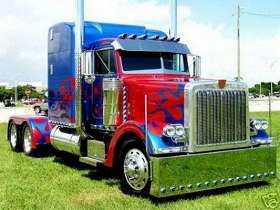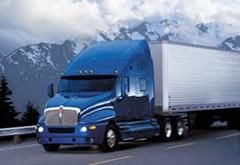The Effect Of Vehicle Weight On Stopping Distance
Topic 30077 | Page 2
My experience is opposite from what the CDL manual says. I can stop an empty truck in a shorter distance than I can a fully loaded one. I actually surprised myself once with an empty flatbed trailer. I had to get on the brakes hard and it came to a stop remarkably well. The ABS system kicked in and did it's job amazingly well. I was impressed by the way it all took place.
I am certain that statement in the manual was made before we had ABS brake systems on our tractors and trailers.
CDL:
Commercial Driver's License (CDL)
A CDL is required to drive any of the following vehicles:
- Any combination of vehicles with a gross combined weight rating (GCWR) of 26,001 or more pounds, providing the gross vehicle weight rating (GVWR) of the vehicle being towed is in excess of 10,000 pounds.
- Any single vehicle with a GVWR of 26,001 or more pounds, or any such vehicle towing another not in excess of 10,000 pounds.
- Any vehicle, regardless of size, designed to transport 16 or more persons, including the driver.
- Any vehicle required by federal regulations to be placarded while transporting hazardous materials.
Yes, Davy, the article mentions truck suspension in the braking distance/traction thing. Heavy weight pushes the tires into the roadway (duhh!) and an unloaded suspension has all that springiness that does NOT push the tires down (Duhh! again).
Further in the Keating article, if you have the patience to read more, there is this passage:
This would lead one to think that loaded trucks take longer to stop than empty ones, but I'm afraid that's not right. The breaks, springs, shock absorbers, and tires on heavy load trucks are specifically designed to work better when the vehicle is loaded.
This means that empty trucks take longer to stop than loaded trucks, and require a greater stopping distance. There is less traction with an empty vehicle. One can end up bouncing and locking up their wheels, which results in much poorer breaking times.
Another law bog (Shannon Law Group) states this:
Weight [factor]:
The weight of the truck will also have a significant impact on braking distance. The heavier the vehicle, the more work the brakes must do to stop it, and the more heat they absorb. The brakes, tires, springs, and shock absorbers on heavy vehicles are designed to work best when the vehicle is fully loaded. Though it may seem counterintuitive, empty trucks require greater stopping distances because an empty vehicle has less traction.
Eerily, they come to the same conclusion!!
Then there's this forum topic on reddit (Can a full loaded truck stop faster (using brakes) than an empty one?), which I did not include here because it is waaaay to technical:
Since rolling friction is higher than sliding friction, max declaration will occur just before tire lockup – this is called threshold braking. So how does adding cargo affect this? When you add cargo to the back of a truck, it will often change the location of the cg, whereby changing the weight distribution which in turn changes the weight transfer and ideal brake bias for a given level of deceleration.
What would make the hand rubbing scenario more realistic is as your moving one hand forward firmly I take my hand and keep pushing it forward. That’s certainly what happens to me when I trying to stop with 18 pallets of half gallons of milk. And thinking a loaded food grade tanker would stop faster than a empty would defy logic. The surge will knock you 6 feet into an intersection if you’re not careful. Abs or not.
You asked for member opinions & thoughts, but if they disagree with yours that's a problem?
Drops mic.
I have no problem with anyone disagreeing, but it sounds like you do Errol. I'm just having a normal conversation. I don't know what you're getting upset about.
Websites copy/paste stuff from each other all the time. All they're doing is creating an echo chamber where everyone repeats what everyone else is saying. Just because many people say something doesn't make it true.
Well, I've yet to hear any evidence, only theories, that a loaded truck stops faster than a lighter truck, as if the energy of the extra 46,000 pounds wasn't in the equation.
Where's Kearsey? She's in good with the higher-ups at her company. Maybe she can talk them into doing a little test somewhere, see which stops faster. I'd put my money on the empty truck on dry roads.

Old School wrote:
My experience is opposite from what the CDL manual says. I can stop an empty truck in a shorter distance than I can a fully loaded one. I actually surprised myself once with an empty flatbed trailer. I had to get on the brakes hard and it came to a stop remarkably well. The ABS system kicked in and did it's job amazingly well. I was impressed by the way it all took place.
I am certain that statement in the manual was made before we had ABS brake systems on our tractors and trailers.
Same experience for me with empty dry vans and reefers.
However... add a bit of moisture to the road and it changes everything. Cannot emphasize that enough to newer drivers.
CDL:
Commercial Driver's License (CDL)
A CDL is required to drive any of the following vehicles:
- Any combination of vehicles with a gross combined weight rating (GCWR) of 26,001 or more pounds, providing the gross vehicle weight rating (GVWR) of the vehicle being towed is in excess of 10,000 pounds.
- Any single vehicle with a GVWR of 26,001 or more pounds, or any such vehicle towing another not in excess of 10,000 pounds.
- Any vehicle, regardless of size, designed to transport 16 or more persons, including the driver.
- Any vehicle required by federal regulations to be placarded while transporting hazardous materials.
Dry Van:
A trailer or truck that that requires no special attention, such as refrigeration, that hauls regular palletted, boxed, or floor-loaded freight. The most common type of trailer in trucking.Reefer:
A refrigerated trailer.

With the caveat that I'm not (yet) a truck driver, I've noticed a similar counterintuitive statement under the "combination vehicles" section..."You also must be very careful about driving "bobtail" tractors..Tests have shown that bobtails can be very hard to stop smoothly. It takes them longer to stop than a tractor-semitrailer loaded to maximum gross weight."
It seems like this is the same physics concept(s) at play here. Clearly the consensus is that friction/ traction trumps inertia. There must be some studies on this....
Bobtail:
"Bobtailing" means you are driving a tractor without a trailer attached.
Combination Vehicle:
A vehicle with two separate parts - the power unit (tractor) and the trailer. Tractor-trailers are considered combination vehicles.

Well, I'll put in my 2 cents: As Brett says, it has to do with momentum. But Errol essentially said that heavier and faster trucks take more force to stop. Momentum is speed times weight, so they are really saying the same thing: Faster and heavier trucks take more force to stop. That force comes from friction in the brakes and friction between the tires and the road. For this discussion I think we're assuming brakes in good condition can provide more than enough friction. That is, the brakes will lock up and you'll start skidding instead of the brakes not having enough power to lock up the wheels.
So I think it comes down to comparing the momentum of the truck to the traction that the tires get. It seems obvious that the traction increases with the weight of the truck, whether the roads are icy or dry. So the question is, how does the increased traction compare with increased momentum as the truck gets heavier and everything else stays the same. I don't know the answer, but I do think it's a little difficult to say based on experience, since I doubt many of us have applied maximum braking and measured the stopping distance in different conditions and weights. On the other hand, it is true that sometimes a "truth" gets published somewhere (like the fact that the momentum and the traction increase equally so that stopping distance stays the same) and everyone repeats it, and in reality it was wrong all along.
So, bottom line, with all due respect to everyone here, I don't know the answer but in my humble opinion I don't think we can really say the conventional wisdom is wrong based on driving experience.
My opinion here may not matter much since I haven’t gotten behind the wheel of a rig yet but.... I have 25 years under my belt driving with utility trailers loaded with landscape equipment and dump trailers with bulk materials(mulch, soil, stone, etc...). I have always had to start braking much earlier when loaded then empty. I could feel the weight pushing me loaded, empty was like the trailer wasn't even there
I was driving F-250/2500 series pickups and stake body/light dumps during this time. All had hydraulic brakes, I know air brakes take a split second longer to engage vs hydraulic but I have always played it safe. More weight=more distance

With the caveat that I'm not (yet) a truck driver, I've noticed a similar counterintuitive statement under the "combination vehicles" section..."You also must be very careful about driving "bobtail" tractors..Tests have shown that bobtails can be very hard to stop smoothly. It takes them longer to stop than a tractor-semitrailer loaded to maximum gross weight."
It seems like this is the same physics concept(s) at play here. Clearly the consensus is that friction/ traction trumps inertia. There must be some studies on this....
Driving a tractor without the trailer attached (Bobtail) is very tricky and indeed does require extra care when driving. They bounce around like a hard rubber ball...
So the statement in the manual is highly accurate.
Bobtail:
"Bobtailing" means you are driving a tractor without a trailer attached.
Combination Vehicle:
A vehicle with two separate parts - the power unit (tractor) and the trailer. Tractor-trailers are considered combination vehicles.
New Reply:
New! Check out our help videos for a better understanding of our forum features

















Preview:
This topic has the following tags:
High Road Training Program Tips For Braking







 TT On Facebook
TT On Facebook
I have very little if any experience, and hopefully not trying to interject anything too ignorant. I also dont know if it is applicable, but the clip about the article mentions suspension. At least on a motorcycle, and car as well, the suspension functions to disperse weight to the wheels and tires under breaking. When entering turns or stopping, we load the front tires up with weight, it increases traction and friction to the tires that need it. As we exit the turn, we accelerate, the rear suspension compresses and transfers the weight to the rear tire which is receiving more force against its contact patch. Lighter bikes, or bikes with less weight on them at the tires accelerate better but take longer to stop in the sense that they are more prone to exceeding grip and thus skidding.
If you have ever driven and empty pickup truck on a washboard gravel road and braked hard, you may have noticed that it takes it longer to stop than the same pickup loaded. Im assuming that the suspension in a truck and trailer has similar characteristics, I would think it would be stiff enough to handle the loads that it might not transfer weight to the wheels and tires as effectively when empty?